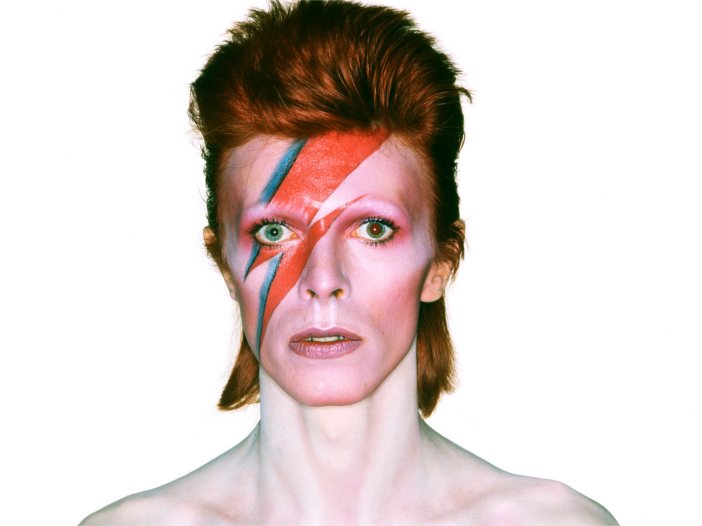Too beautiful to live; too elegant to grow old – and David Bowie is dead.
The pop superstar/artist’s passing took millions by surprise. The news led bulletins around the world, including the serious BBC morning programme. When I caught the tail end of the headlines I thought I must have misheard – it must have been a reference to the musician’s birthday, 69 last Friday, or the release of his latest album, Blackstar.
Bowie was one of the most famous people in the world – if you doubt it, check out the international coverage of his death from cancer, in the clichéd phrase “after a long battle”. In Melbourne last August, I went to the big exhibition about Bowie which has been touring the world since its premiere at London’s Victoria and Albert Museum in 2013 – currently it’s at the Groningen Museum in the Netherlands.
Mentioning this visit to a relative later, she vaguely asked “What does David Bowie do?”
That response, apart from eliciting mirth and incredulity, poses a question that the same exhibition literature attempted to explain: “one of the most pioneering and influential entertainers of modern times,” it summed up, adding “Bowie’s work has both influenced and been influenced by wider movements in art, design, theatre and contemporary culture”.
But apart from all that, he was our Dave. Born in 1947, he was a decade ahead of my cohort, but that meant he was established as a fascinating and androgynously appealing figure by the time we hit our teens. It seems people have been calling into talk shows and going online to record their “bumping into Bowie” moment in the streets, and how cool he was. Cool was what it was all about. My own sighting was at one of the iconic music venues in New York – CBGB’s – in the early ‘80s. Bowie was not performing, but there with friends, being pretty much left alone by the awestruck customers. The palette inside the club that night was black and grey, with graveyard lighting giving everything a tombstone effect. That sharp profile of his needed no colouring to glamourise, however.

Bowie, whose first big hit was ‘Space Oddity’ in 1969, was an integral sound of the seventies, with the studio albums The Rise and Fall of Ziggy Stardust, Low, Heroes, Station to Station, Pin-Ups, Hunky Dory, Diamond Dogs and Young Americans all coming out in that decade.
Even the Archbishop of Canterbury, Justin Welby, pinpointed the 1970s as his peak Bowie era, in an interview with BBC Radio 4. “I remember sitting listening to his songs endlessly in the ’70s particularly and always really relishing what he was, what he did, the impact he had.”
Bowie’s obsession with space, from Space Oddity to Blackstar, is symptomatic of the baby-boomer generation. Space, the “final frontier”, was attacked with the Russian and American explorations of the late 1950s and 1960s, culminating in the moon landing in 1969 – the same year that Space Oddity became his first huge hit.
Social media has been pulsating with tributes and sadness from all age groups, but particularly those who remember the young, fabulous-looking Bowie who bobbed up in the movies The Man Who Fell to Earth (weird indeed) and Merry Christmas Mr Lawrence. His film career continued sporadically, and always added a touch of gleeful style, as in his appearance as Nikola Tesla in 2006’s The Prestige, or the compere of the fashion “walk-off” in Zoolander.
[youtube id=”yQ6bolOsx8s”]
He was in some ways the pop culture wallpaper for my generation – and not just the ubiquitous music, on the radio or at the clubs. Bowie was always out there, doing something different, edgy, odd, looking fabulous if increasingly strung out. His drug use became extreme, according to his biographers, in an age when hard drug use reached and ruined the streets. His music was the alternative to the mass-produced trend; there were plenty of good melodies, songs to dance to. But it was the haunting lyrics and the recurring embrace of alienation that made his music an indispensable accessory of youth.
In the 80s he slowed down slightly, but still created Scary Monsters and Let’s Dance, with the mega-hits ‘Ashes to Ashes’ and ‘Let’s Dance’ itself respectively. I can remember the wild excitement of his Serious Moonlight tour concerts in Melbourne (despite leaving one of the tickets at home and making my boyfriend drive back while I sailed on in). Bowie, apparently, was taken aback by the success of the tour, and the massive popularity of Let’s Dance itself.
[youtube id=”hQDG6kjMgoA” align=”center” autoplay=”no” maxwidth=”702"]
He was one of the key performers at Live Aid in 1985, burnishing his already godlike status for many. It was Bowie who performed the London half of the “duet” with Mick Jagger on ‘Dancing in the Street’, singing at Wembley to a pre-recorded film of Jagger who headed the concert in Philadelphia. (And giving rise to the video above, very dated-looking now.) He also performed the fantastic ‘Under Pressure’ with Freddie Mercury.
And yet, he kept going, he kept coming out, at longer intervals, with new work, while maintaining his personal dignity. To borrow from Elton John or Marilyn Monroe, “you had the grace to hold yourself, while those around you crawled”.
David Bowie’s music and art were a safe backdrop to our generation: you could rely on him to take the risks, and produce the goods, that let the rest of us off the hook to live ordinary, humdrum lives.
Rest in peace.
Featured Image:
Photography by Greg Gorman.

